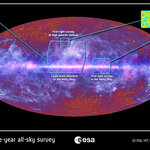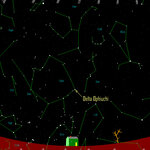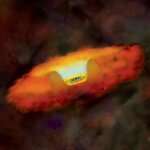Space
How high is space, how far can you fall with a parachute, where is the Project Calliope satellite going to be, and where does the hard radiation from the sun get nasty? Gathered for the first time in one place is our High Altitude Explorer's Guide.
A typical airplane cruises at 9km (6 miles) up, around 30,000 feet. Military jets (from the SR-71 onward to modern planes) can hit over 30km (19 miles) up, over 100,000 feet.
Can you parachute from that height? Yes, in 1960 Joseph Kittinger set the record at 31.3km (19.5 miles), or 102,800 feet. Felix Baumgartner is trying…

The black hole at the edge of galaxy NGC 7793, twelve million light years from Earth, has been found to be doing something rare - emitting powerful jets of particles of a total length of 1,000 light years. The energy produced by matter falling into a black hole this size is usually transformed into X-rays, not into jets, but this one is the exception - a miniature version of certain supermassive black holes present in the active nuclei of galaxies.
The two jets of matter that they observed are the most powerful ever discovered for this type of black hole, resulting from the collapse of…

Just a quickie here. So I'm reading a comic book, Marvel's "Ultimate Galactus". In it, a godlike being named (in Kree... not Cree, but Kree) Gah Lak Tus is attacking the Earth, sending superpowered agents to destroy our only rocket by which humans might escape.
It's supposed to be present day, not the far future. Yet here's what they ask us to believe. There's an army of invisible custom-designed aliens including 'killforms', mutated clones, an alien Kree with a power suit that fits into a single armband, faster than light travel. The aliens destroy the NASA rocket. NASA says they can roll…
What do you get when you mix politics and space exploration?a) an impenetrable messb) an interesting clash between technology and peoplec) something scarier than sausage making
For those who think politics is messy or scary, I agree. But it makes for good reading. And when you read space politics, you also get nice logo-like images like this one.
I've covered some of the 'people' issues abut space exploration, most recently in . But I'm focused on just getting my lil' old satellite up. What's the picture for getting people, space stations, nuclear reactors, and kitchen sinks into space…

ESA’s Planck mission is a 'time machine' to study the relic radiation from the Big Bang, and it has delivered its first all-sky image, one of four all-sky scans it will complete by the end of its mission in 2012.
Planck is designed to map tiny irregularities in fossil radiation left over from the very first light in the Universe, emitted shortly after the Big Bang, and has enough sensitivity to reach the experimental limits of what can be observed, allowing researchers to peer into the early Universe and study its constituents, perhaps even the hypothetical dark matter and dark energy that…

It's been a good month for cosmic wonderment. The Wide Field Imager (WFI) at ESO’s La Silla Observatory in Chile caught the region around the star R Coronae Australis and on June 13th, the Japanese spacecraft Hayabusa returned after 7 years and 1.25 billion miles on a mission to gather material from the comet Itokawa.
It exploded over the Australian outback - intentional, it seems, since it had parachuted its cargo already. At least we hope it has cargo. It experienced some malfunctions on the trip and the researchers will let us know, since they have already picked it up.…

Ever wonder what the future of space tourism will be? This series of posters (from the same collection as last week's spaceport illo) in neo-retro style clearly presents your options.
Although I found these originally on the very cool DarkRoastedBlend page, I am more pleased to find that the original artist, Steve Thomas, sells them as posters (at reasonable prices, some at $15 or less!) For those of you too young to know what a 'poster' is, it's like your desktop wallpaper, only made out of paper and hung on the sides of your cube or bedroom.
I like the lunar tourist is doing the…

You are all familiar with a solar eclipse, when our Moon passes in front of the Sun and blocks its light, but a similar situation can happen with asteroids, those Sun-orbiting, rocky objects left over from the formation of the Solar System or formed by collisions between other asteroids.
We know of about 400,000 asteroids, which range in size from a few hundred kilometers to just a few meters. Obviously an asteroid is too small to cover the Sun but because of proximity one will occasionally move directly in front of one of the stars in the night sky and block its light from our view,…

While I'm busy building an instrument to convert the ionosphere to music, this NASA group has sonified the Sun.
Astronomers at Univ. of Sheffield "found that huge magnetic loops that have been observed coiling away from the outer layer of the sun's atmosphere, known as coronal loops, vibrate like strings on a musical instrument. [...] Using satellite images of these loops, which can be over 60,000 miles long, the scientists were able to recreate the sound by turning the visible vibrations into noises and speeding up the frequency so it is audible to the human ear. "
"It is a sort of…

Using two of the world’s largest telescopes, the Very Large Telescope (VLT) in Chile and the Gran Telescopio Canarias (GTC) on La Palma in the Canary Islands, an international team of astronomers have found evidence of a collision between galaxies driving intense activity in a highly luminous quasar, SDSS J0123+00.
Several types of galaxies, known as active galaxies, emit enormous amounts of energy from their central region or nucleus, with the most luminous objects known as quasars. Many scientists argue that quasars contain a central black hole, with a mass of at least several million…